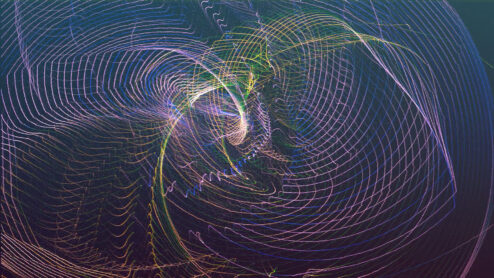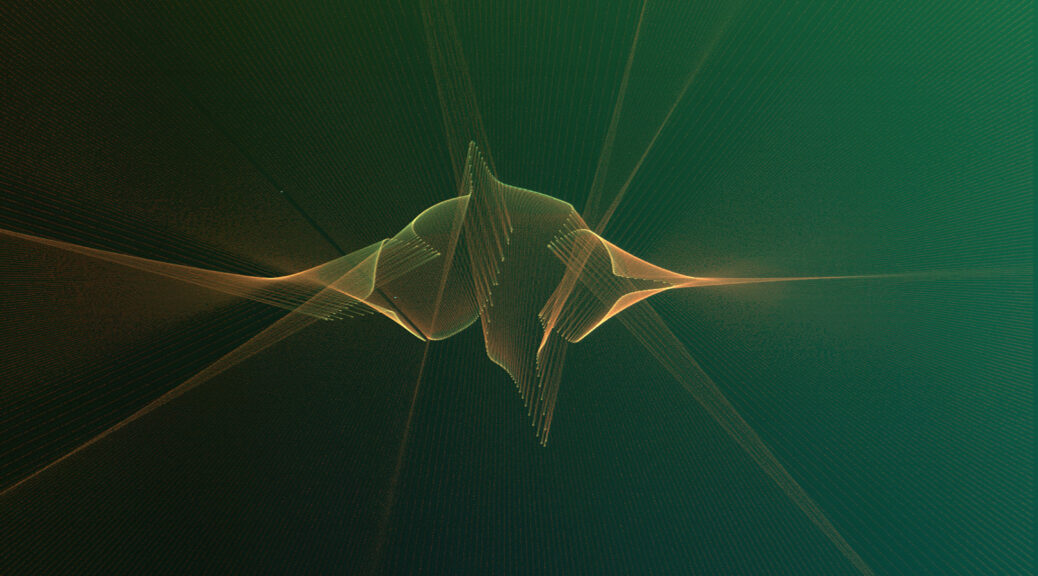Due to frantic activity elsewhere, it has been rather quiet on this page recently, but some time ago already, on the 23rd of May 2023, was the premiere of my latest film “Mechanisms Common to Disparate Phenomena, #59”, at the Eye Filmmuseum in Amsterdam.
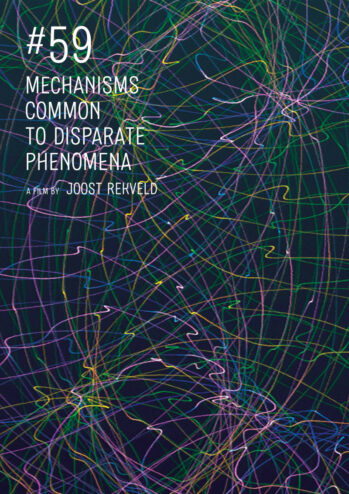
The official blurb of this film currently runs as follows:
“#59 (2023, 79 min., DCP) is an abstract animated science-fiction film that takes the experiences shared by humans and electronic circuits as its starting point. Our computing technology emerged during the Cold War as a byproduct of the development of atomic weapons and their associated planetary surveillance systems. In 1961, at what was perhaps the coldest point of this period, Edward Lorenz and Yoshisuke Ueda independently discovered deterministic chaos in their computers. In film #59, humans, aliens and electronic devices vacillate between these poles of a human fever dream of planetary control on the one hand, and lively machinic chaos on the other.
All images in the film were produced as analog electronic signals, in a re-enactment of antiquated ways of computing. These signals were generated using period equipment, including an analog computer from 1963, early sonar and radar oscillators, and bits from military flight simulators. This film is an attempt to liberate these technologies from their problematic origins.
Narrative elements derived from Cold War era science fiction films set the tone, while references to radar and television scanning result in images that evoke very early computer graphics. These progressively unfold into organic calligraphies, in which the negative space between the patterns becomes one of the protagonists. Resemblances with manmade phenomena are gradually left behind, and the film evolves into a nonverbal meditation on material processes, human perception and the arrow of time.”
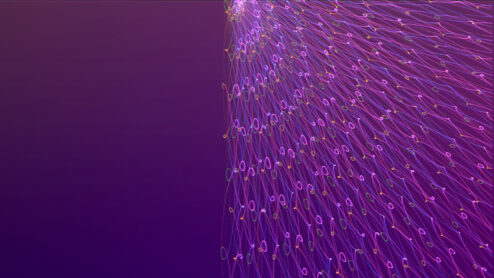
This film is the main artistic outcome of the research project “Dialogues with Machines” that I have been busy with since 2017 at KASK and S:PAM in Ghent, and which I hope to conclude with a PhD defense in the first months of 2024. It is the result of an even longer interest in analog computing, and of a more general interest in a media archeology of analog electronics.
Along the way, the project shifted quite a bit, which resulted in a film that I think is in many ways unlike the films that I made up to now. It has a prologue of 14 minutes which is the first piece I’ve ever made that uses a voice-over (it also exists on its own as “Ueda’s Shattered Egg” (2023, 14 min., DCP)). In the film itself, I use sound to provide context and a running commentary on the abstract animated imagery, and for the first time in my work this includes suggestions of narrative.
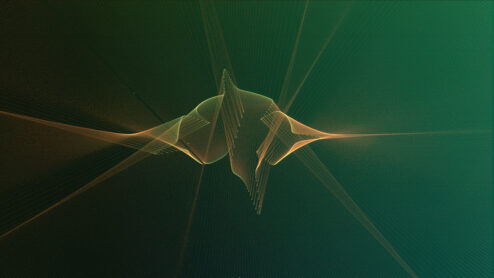
Revisiting the early history of electronic analog computing had two motivations. Analog computing is a way to approach computing that is very different from the thinking around Turing machines, a concept at the hart of our digital computers that seems so general that it is even hard to imagine there could be an alternative. I was fascinated to go back to a time when such alternative ways of thinking actually had a real-life existence. This seemed a productive strategy to develop a different perspective on current developments in computing and understand some of its aspects better. In 2015, at the beginning of this project, I wrote a blogpost about the first stage of this historical research. This has continued to escalate since then and became part of a larger research undertaking that also involves the history of cybernetics. I will share the results of that at another moment.
The second reason was speculative in a more practical sense: to use that early history as a starting point for imagining other scenarios and to try to develop artistic uses of analog computing technology that were not possible or conceivable at the time it still existed. How would abstract animated films have been made if our image technology would have been all analog electronics ? Which as yet under- or unexplored kinds of synthetic imagery align with the peculiar capacities of these devices ?
In parallel with doing research on the early history of electronic analog computers, I started to restore these machines, and to learn how to use them and how to build one of my own. I restored an EAI TR-48 computer from 1963 (you can also see it here), and to some extent I learned to understand and design analog electronics. Gradually I built a new machine that is roughly equivalent to the TR-48, but which uses electronic components that are much more recent. The result is an analog computer that is based on the same fundamental operations to calculate with voltages, but which is several orders of magnitude faster; the TR-48 works extremely precisely up to around 1 KHz, the machine I built is a lot less precise but works with frequencies up to 50 MHz. The first idea was to use classical analog computing methods to generate HD video signals.
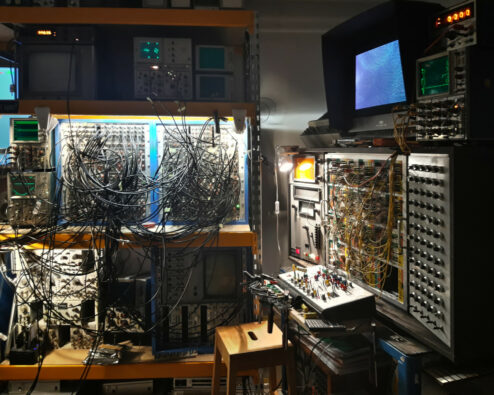
Then two things happened that shifted this project conceptually. Analog computers are really good at doing chaos and I spent quite some time exploring many different existing chaotic equations, inventing some of my own (some early examples of that research you can see here again, but also here, here, and here). But the vector displays that turn these chaotic signals into images on a phosphor screen have one big disadvantage: it is impossible to do complex images in colour and I simply did not want to do yet another work in black and white (such as #67 for instance).
Luckily, a friend tipped me off about the sale of a rare device called a stroke-to-raster converter. This is essentially a kind of capture card for fast electronic signals, a device that converts these signals into a two-dimensional video image in the same way as a vector display or XY-display would display these signals on a phosphor screen. One crucial difference is that it can do colour: it does not only take the XY-signals that draw shapes by moving the ‘beam’ around on the screen, it also takes RGB signals that determine the colour of the line that is being drawn. In this way, it became possible for me to use my analog machinery to do real-time animation in colour, enabling all kinds of new (to me) forms of visceral collaboration with machines.
But the biggest conceptual shift in the project was not caused by the capabilities of these devices, but by their origin. The seller told me that this particular stroke-to-raster converter came from a military flight-simulation facility. It was designed to convert the analog signals that are used in the cockpits of fighter jets, translating numerical information and radar imagery into video images that could be superimposed onto landscape footage.
By that time, such a military origin was not a surprise to me anymore. Over the few years before that, I had been collecting all kinds of vintage high-frequency analog equipment. As an unintentional side effect, my studio had become a miniature image of sorts of the military-industrial complex. Many of the machines that I was using in my studio had stickers from previous owners: university labs with clear military connections, military labs working with radar and sonar, or companies working in developing or maintaining aviation and missile technology. The type of high-end equipment that I was collecting came from the same Cold War military-industrial environment where analog computers were developed, but two decades later. This especially hit home when a Tektronix plugin arrived that had served in the Los Alamos Scientific Laboratory, the birthplace of the atomic bomb.
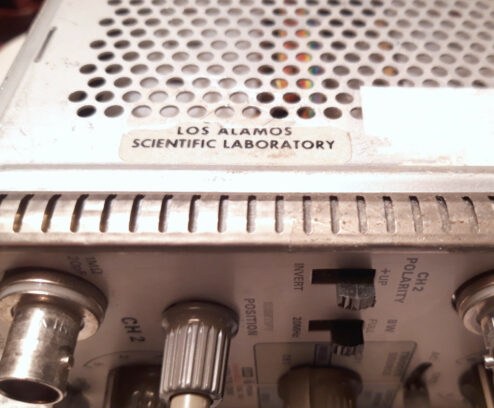
Sensitive to this context, I started to be intrigued by the fact that chaos was ‘officially’ discovered in the early 1960’s, at the height of the Cold War. Edward Lorenz discovered chaos in the weather equations that he was modeling on a small digital computer. Around the same time, Yoshisuke Ueda discovered chaos in the equations that he was studying with a small analog computer. A fantastic technical-cultural-historical study about that period helped in connecting these dots with others: the 1996 book by Paul Edwards: The Closed World; Computers and the Politics of Discourse in Cold War America. Edwards (amongst many other things) shows how the development of analog computers and the development of the first global surveillance systems took place in the same context.
It was utterly fascinating to me that chaos emerged in devices that were developed to model, monitor and control, and that this occured exactly at the moment these devices were starting to be used to monitor the entire planet, looking for approaching enemy rockets. This simultaneous emergence of global control and inherent chaos became the conceptual basis for my film. Also I started to see my personal variety of media-archeology as an attempt to liberate the technologies that I was using from their problematic origins.
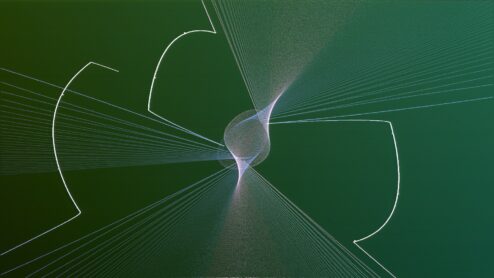
In early 2024 I will publish a small book with a long essay that I wrote as context for this film, developing the points mentioned above and many more. It will also narrate how this project has helped shape my view on technology as a form of collective memory and media-archeology as a method for conversing with it.
The film had several screenings at smaller festivals and at the end of March 2024 it will finally have its A-list festival premiere at the Ann Arbor Film Festival (an interview with programmer Brandon Walley can be found here). If you are interested in screening or reviewing it you can contact me here (you can also contact me for that analog or hybrid computer that you have lying around 😉 ).
In the meantime a few reviews have appeared:
– this great review in Dutch by Dana Linssen in De Filmkrant,
– an interesting but more ambivalent review by Michael Sicinski found here (but also here)
– a nice short review by Alex Fields on Letterboxd (later version here)
– a nice review by Daniel Gorman.
